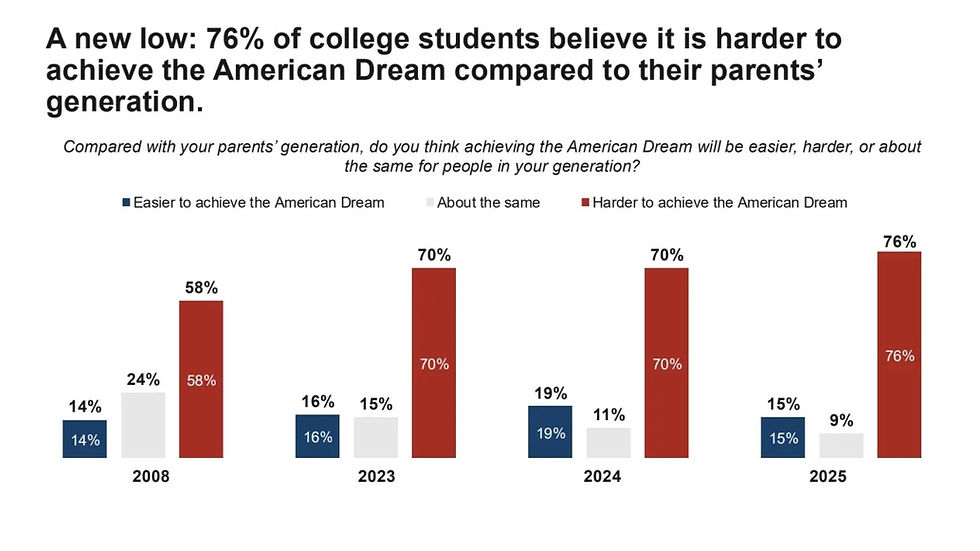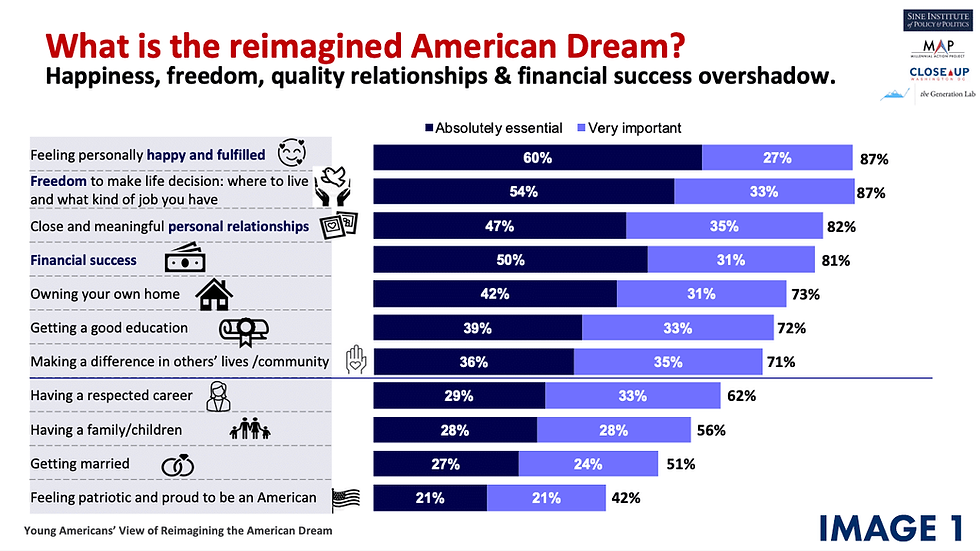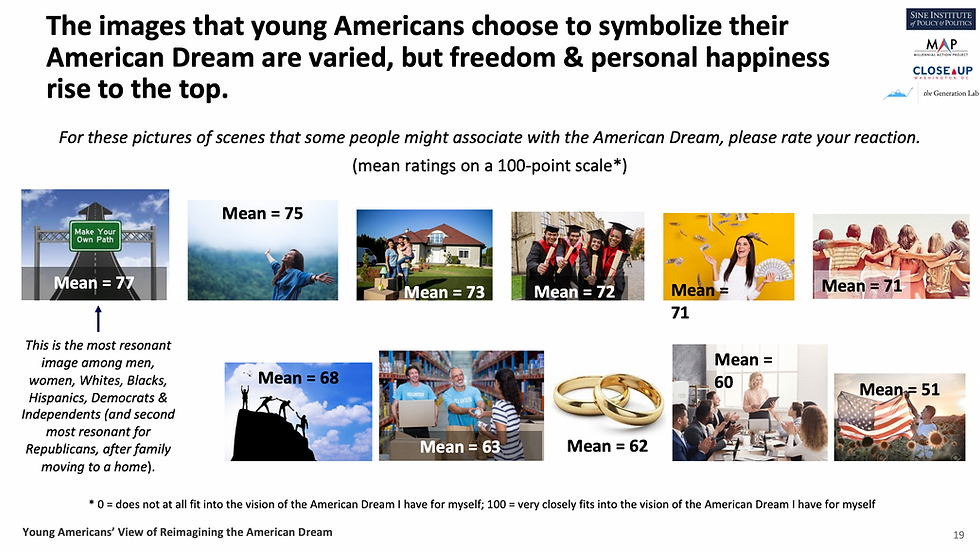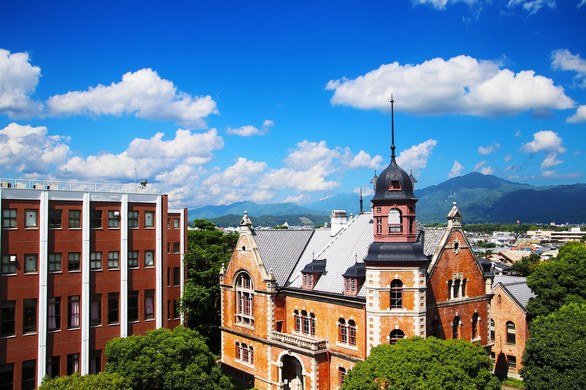Exploring the American Dream: A New Perspective
- Mai Ryuno
- Jul 3
- 5 min read
Updated: Jul 12
I recently read the local newspaper article about the American Dream: Panetta Institute survey reports college students believe less in the American Dream
The survey results, gathered from 809 college students across the nation, highlighted several concerns. Students are worried about the cost of living and the state of American democracy. A staggering 75% believe it will be harder for them to achieve a better life than their parents and realize the American Dream (Valadez, Monterey Herald, 2025).

Understanding the American Dream
The concept of the American Dream dates back to the Declaration of Independence. This foundational document emphasizes the pursuit of life, liberty, and happiness. Over the years, this idea has shifted in response to historical events, economic changes, and cultural movements.
After World War II, the American Dream became entwined with suburban living. Many sought economic prosperity and the nuclear family model. Home ownership became a significant goal. However, as we fast forward to today, the narrative has changed dramatically. Economic instability and social justice issues have risen to the forefront.
I was intrigued to learn about James Truslow Adams, who popularized the term "American Dream" in his 1931 book, The Epic of America. He defined it as "that dream of a land in which life should be better and richer and fuller for everyone, with opportunity for each according to ability or achievement."
Adams emphasized that the American Dream was not just about material wealth. He envisioned a social order where everyone could reach their fullest potential. This should occur regardless of circumstances of birth or position. It's curious that Adams, born into a wealthy family, worried that the American Dream was becoming overly focused on "money making and material improvements," losing its "quality and spiritual values." This reflects his hope for a better future for all Americans.
As an immigrant from Japan who moved to California over 20 years ago, my childhood dream was to make friends around the world. I chose the United States because I was an exchange student in college. I was excited to learn about its diverse society and meet new people. Coming from a country where differences between people are less pronounced, I found this diversity exhilarating. However, I also witnessed the challenges faced by people due to their different backgrounds.
Concerns of Today's Students
According to the Panetta Institute survey, students' top concerns are the cost of living and healthcare. Additionally, 55% of students feel that American democracy is not functioning as it should, marking a nine-point increase from last year's survey and a historic low.
These findings led me to reflect: Is the American Dream in the 21st century defined by a lower cost of living, accessible healthcare, or higher wages? To what extent is the government responsible for achieving it?
The American Dream Today
I found another survey from The Sine Institute of Policy and Politics at American University. It explored young Americans' evolving concept of the American Dream. This survey included 1,568 individuals aged 18 to 34 and suggests that while young people still believe in the idea, they view it differently than past generations. (Wilson, Close Up, 2023) Happiness, freedom, and meaningful relationships are now considered core components of this reimagined American Dream.

Moreover, 62% believe their lives will be better than their parents', but they worry about having a functional and effective government. While they view education as vital, they see current political circumstances as obstacles.
Dreams for Future Pathways
Dreams often feel like a luxury, especially when daily life feels demanding. It's hard to separate dreams from reality, not just physically but also intellectually.
I was fortunate that my parents encouraged me to pursue education anywhere in the world. They emphasized that I didn’t have to study solely for practical reasons. In the 1980s Japan, this was a significant perspective. I remember asking my teachers about overseas schools, but they recommended local institutions, lacking the resources to explore international options. Following their advice, I graduated from local junior high and high school but dedicated myself to studying English. This prepared me for the day I would find a path to fulfill my dreams. Eventually, I earned a BA in English Letters from a university outside of my hometown.
Left: Tiny Me playing with a tripod | Right: College I attended in Kyoto with a New England-style building
Fifteen years after first sharing my dream with my parents and teachers, I finally moved to California. At that time, I had a new dream: to become an artist. This dream may have stemmed from my mother’s unfulfilled aspirations, inspired by her constant doodling and creative perspective.
While becoming an artist was my goal, attending a community college in California was driven by curiosity. I wanted to learn about art and make friends outside of Japan. In this way, these two dreams combined to shape my path and motivated my learning.
The Sine Institute survey revealed that "making your own path" resonates most with young people today. This suggests they have a broader view of dreams for their future, finding that achieving personal aspirations is increasingly essential for a nation's success and development.

Education for Free Dreaming
However, if young people's dreams are limited to fulfilling daily life, we may not nurture a generation equipped to address larger societal and global issues. Securing basic needs, such as access to well-paying jobs, is crucial for physical well-being. At the same time, education can broaden their perspectives. It encourages thinking about their communities and the world beyond immediate experiences.
I saw this firsthand as an educator during the recovery from the 2011 Great East Japan Earthquake and Tsunami. We invited students to envision their ideal future communities. To make these dreams real, young people and adults collaborated on community action and positive change. The imagination of these students brought hope and unity.
Empowering the next generation to achieve their version of the American Dream means allowing them to dream freely. They should act boldly without fear of making mistakes. It's about encouraging the pursuit of true aspirations supported by adults.
Education should create a space where young people can dream without immediate pressures. It should also be a place where they learn to turn dreams into reality. Art plays a crucial role here. Creating art begins with an artist's imagination and dreams, bringing new creations into existence.
Nurturing imagination and granting space for free dreaming are powerful tools for personal growth, creativity, and shaping new realities. When young people learn to dream beyond their current reality and believe in their ability to manifest these dreams, they can drive the changes needed for a better future for themselves, their communities, and the world.










Comments